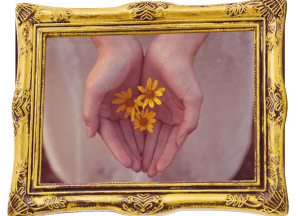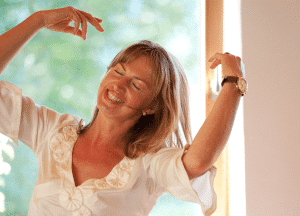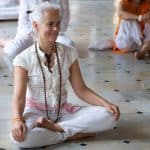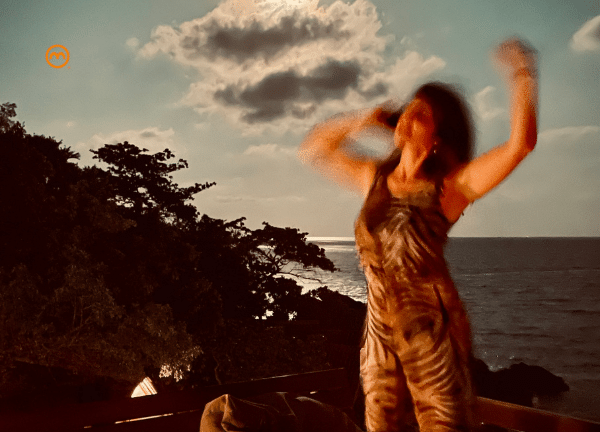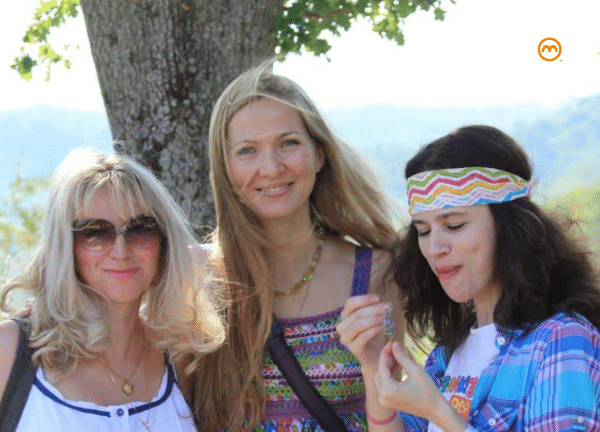
“I’m not Worth Being Loved” – And What Really Lies Behind It
April 21, 2025
Female Energy – Mirror of Being
August 14, 2025Do you know the feeling of being constantly under pressure inside? You long for more calm in your everyday life, want to stay calm in stressful situations – but instead you often react impulsively or feel overwhelmed. Calmness seems to be something that some people just bring with them, while others have to work hard to learn it.
The good news is that you can learn calmness. And not only that – you can become calmer, more balanced and more relaxed without turning your life upside down. In this article, I’ll show you how you can sort yourself out step by step, stress yourself out less and finally feel calm again: I am completely calm – even when the storm is raging outside.
Learning serenity: introduction and basic understanding
Before we explore how to live, practise and even embody serenity in everyday life, it’s worth taking a look at the roots of this word. What exactly do we mean when we talk about serenity? And what distinguishes it from indifference or mere functioning?
Serenity – the definition in the Duden dictionary
According to the Duden dictionary, serenity means a calm, imperturbable attitude towards difficult situations. It is not about not feeling anything – but about remaining stable inside, even when there is chaos on the outside.
Is composure a skill?
Yes, serenity is a skill – it can be trained like a muscle. It is not innate, but is developed through practice, mindfulness and inner work. People who appear calmer and more composed have often learned to deal with stress better.
Serenity can be learned
This is the essence of this article: calmness can be learned – by making conscious decisions, practising inner calm and gaining new perspectives. It’s not magic, but a path of development.
Can you learn to become calmer?
Absolutely. With specific techniques, you can learn to stay calmer – both in stressful moments and in everyday situations. The key is to allow yourself to stop trying to control everything.
Psychology and emotional regulation
Becoming more serene in psychology
Psychologically speaking, calmness is closely linked to resilience, self-regulation and the ability to recognize thought patterns. If you know how to deal with stress, you will go through life more relaxed.
How can I become more relaxed and anxiety-free?
By learning to accept your fears instead of fighting them. Breathing exercises, body awareness and inner anchors help you to become calmer and react less to external triggers.
How can you learn not to get upset?
Instead of reacting immediately, you can learn to pause. Ask yourself: Do I really need to react now? It often helps to take a short breath and turn your focus inwards. Not everything deserves a reaction.
How can I go through life calmly and relaxed?
By accepting that you can’t control everything. Learning serenity also means not wanting to change yourself or others. You must not make your peace dependent on the outside world.
How do you go through life relaxed?
By putting less pressure on yourself. You are not a project – you are a person. Allow yourself to be “not perfect” sometimes. That is true relaxation.
Finding inner peace
In a world that constantly demands our attention, it is becoming increasingly difficult to find peace. But inner peace is the foundation for serenity and mental health. If you want to learn to become calmer and more relaxed, then your path starts right here: with yourself – within yourself. Let’s look together at how you can find your way back to your calm, clear core.
How can you find inner peace?
To find inner peace, you don’t need time out in a mountain hut – but the willingness to get closer to yourself again. It starts with small moments: a conscious breath, a walk without your cell phone, a quiet look at the sky. The more often you pause, the easier it will be to stay calm, even in stressful situations.
How do I find inner serenity?
Inner serenity does not come from avoiding stress, but from dealing with it. Instead of allowing yourself to be determined by external circumstances, you can learn to act from within. Mindfulness, breathing exercises and regular breaks help you to become calmer – even when the world keeps turning.
How do you find inner peace?
You don’t find inner peace on the outside – it starts with a change of perspective. Ask yourself: What can I not control right now? And what would happen if I just let go? It’s often holding on that makes us restless. If you learn to let go, you will automatically become more relaxed and calm.
How do I find inner peace again?
Sometimes we lose the connection to our inner peace – through worry, exhaustion or constant stress. The way back starts with compassion for yourself. Treat yourself to a time-out, even if it’s just ten minutes. Make it a priority to reconnect with yourself. Because more serenity in everyday life always starts with the moment you stop rushing yourself.
How do I learn inner peace?
Inner peace can be learned – just like any other skill. It requires repetition, patience and loving discipline. You can practise calmness by regularly asking yourself: “What do I need to stay calm right now?” Meditation, nature, consciously doing nothing – find your own personal way to become calmer inside.
What to do if you can’t find inner peace?
If you have the feeling that you never find inner peace, this is a signal. Maybe it’s time to change something – your habits, the way you deal with stress or your expectations of yourself. It’s okay to get help. And sometimes it also helps to simply say: sometimes you just have to stay calm and smile.
How can you find inner peace?
You can ask this question more often – not just once. Because inner peace and serenity are not end goals, but daily decisions. Perhaps a ritual in the morning, a journal in the evening or a regular break from the constant digital noise will help you. Start small – and you’ll notice: You can stay calm, even when life gets noisy.
Effect and charisma
Serenity doesn’t just show on the inside – it has an effect. People who are at peace with themselves radiate something that others sense: calm, clarity, confidence. Perhaps you have already experienced someone who conveys a sense of security through their presence alone. In this section, you will learn how you can radiate more calmness and naturally reassure those around you – without having to say anything.
How do I radiate more calm?
We radiate calmness when we are clear and connected inside. This doesn’t start with a ‘correct’ facial expression – but with an inner yes to what is happening right now. If you don’t fight against the moment, but embrace it, your whole posture changes. You become slower, softer, more open. Your surroundings will sense this.
Radiate serenity
Radiating calmness means not having to comment on everything. Not every provocation deserves a response. It means being present in the conversation without being constantly in your head. When you learn to take yourself back instead of justifying yourself, you develop this special aura of calm and confidence. You become a haven of peace – simply by being.
Specific tips and offers
You may be thinking now: That all sounds great – but how do I get started? This is exactly where your personal serenity training begins. You don’t have to turn your whole life upside down – small, mindful steps are often enough. In this section, you will find practical tips on how to become more relaxed, stay calmer in stressful situations – and develop more serenity in your everyday life in the long term.
What tips are there for learning to stay calm?
Here are my favorite tips for more serenity:
- Breathe consciously – deep into your belly, slowly and calmly.
- Move regularly – not for performance, but to ground yourself.
- Avoid being constantly available – your cell phone can be offline sometimes.
- Say no more often – to things that upset you.
- Make breaks visible – put them in your calendar.
And: allow yourself to fail. Staying calm doesn’t mean always having everything under control – but being kind to yourself when things don’t go as planned.
Learn to stay calm Exercises
A small foretaste from the retreat (seminar):
- Close your eyes and place your hands on your heart.
- Breathe in and out deeply three times – as if you were exhaling inwardly.
- Sing an Om sound. Others would say: sound an Om. Feel how your body feels.
Tips for more serenity
Here are a few more simple but powerful impulses for your everyday life:
- Learn not to take everything personally
- Ask yourself more often: Is this really important – or just loud?
- Maintain your routines: sleep, exercise, healthy boundaries
- Read inspiring sayings about calm and serenity
- Allow yourself to do nothing sometimes – and enjoy it
Learn to stay calm
If there’s one thing you take away from this article, it might be this: you can learn to stay calm, even if your surroundings are loud, hectic or demanding. It is not a sign of weakness to take a step back – it is an expression of inner strength. Calmness doesn’t mean that you don’t have an opinion. It means that you know when you want to express them – and when silence is more powerful.
Spiritual perspectives
When we look deeper, beyond everyday life and its demands, we encounter a different dimension of serenity.
Not the one that we laboriously train ourselves to have. But the quiet presence that rises from the depths of being.
Spirituality – in the best sense – invites us not only to act more calmly, but to be calm.
A look at Buddha and his attitude towards the world opens a whole new door.
What is the serenity of Buddha?
When we think of Buddha, we often think of a quiet smile, of a person sitting motionless in the midst of a storm. But this calmness is no coincidence – it is an expression of the deepest insight. Buddha’s serenity is not the result of any technique or mental trick.
It is the natural radiance of a mind that has ceased to become entangled. Not clinging, not rejecting – that means adding nothing to life and taking nothing away. Every experience is allowed to come and go, like a wave in the ocean.
This form of serenity is not cold or distant. On the contrary: it is imbued with clarity, love and an alert compassion. Nothing has to be other than it is – and this is precisely the freedom that cannot be possessed, only recognized.
Those who regularly go into silence, whether through meditation, breathing or pure observation, can approach this quality. Because serenity is not the goal – it is what remains when you stop fighting.
A person at peace with themselves
A person at peace with himself does not react automatically – he responds out of awareness. They don’t have to prove anything, they don’t have to be right, they don’t have to win.
He takes his time, listens, looks deeper. Their calmness is not weakness – it is strength that no longer needs to compensate for anything.
And these people have something you can’t buy: a quiet presence that draws others along, calms them, reminds them. You can learn that. Not overnight. But step by step. With every conscious breath. With every decision not to flee, but to stay.
With every moment in which you let go of what you don’t need – and become still in order to hear what really matters.
And what if you don’t have to do anything to be calm?
Everything you’ve read so far has been ways to practise more serenity – methods, tips, strategies for everyday life. They are valuable. They help you to become calmer and deal with stressful situations more calmly.
But there is a deeper truth that lies beyond all these methods.
A truth that does not need to be trained.
A serenity that is not created, but recognized.
When you open yourself to this dimension, you no longer need techniques – because you recognize yourself as stillness.
And out of this silent realization, something wonderful happens: Serenity radiates out of you all by itself.
It is no longer ‘made’, it is simply there – tangible for others, supportive for yourself.
It underpins your whole life, like an invisible ground on which you walk calmly and clearly – no matter what happens on the outside.
This is exactly where Advaita begins.
Learning serenity in a seminar
If you would like to delve deeper, I cordially invite you to my seminar:
A place where you don’t have to work – but are allowed to be. There you will learn how to anchor inner peace and serenity in your everyday life in a sustainable way. With body-oriented exercises, quiet times, honest exchanges and tools that you can really use.
Because learning serenity can be easy. And you don’t have to do it alone.
And if you want to feel how deep real silence can go – beyond anything personal – then take part in a retreat with Madhukar.
In this special atmosphere, away from everyday noise and roles, you can experience what words can hardly achieve:
An inner state of peace that is independent of external circumstances.
An immediate realization:
These retreats are not a “course” in the traditional sense – they are a space for deep awareness.
For many, this is the moment when serenity is no longer practiced, but lived.
Still. Simply. Genuine.
Hi, I am Shivani
blogger and podcaster at Madhukar Enlighten Life. I have known Madhukar since 2004 and do what I can to ensure that his effective message of happiness reaches many people. This post was penned by me – and ChatGpt helped me a little.



